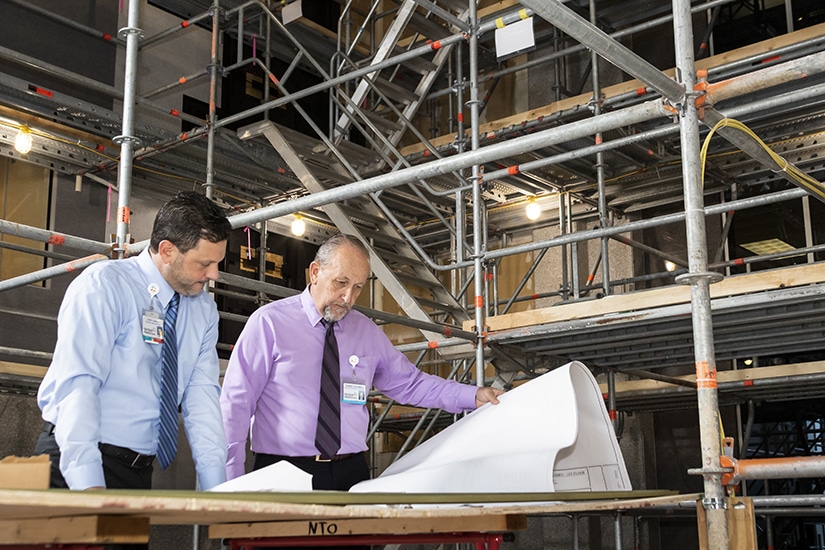|
Getting your Trinity Audio player ready...
|
Thomas Vaccarelli wasn’t in the market for a new job. But when he noticed a posting for an opening at New Britain General hospital while scanning the newspaper classifieds, the private-sector opportunity immediately intrigued him.
“I never thought that it was going to materialize into anything,” Vaccarelli admits. “Then the hospital realized what my background was as I was going through the recruitment process, and that’s how it started.”
What started was the second phase of Vaccarelli’s career—a phase still ongoing close to two decades later. Today, Vaccarelli is vice president of facilities, construction, and real estate at Hartford HealthCare, a vast Connecticut-based healthcare system of which New Britain General is a part. Over the years, he has contributed to the system’s rapid growth by emphasizing the alignment of the physical spaces in which patients receive care with the high standards of care itself that Hartford HealthCare has come to represent.

Before coming on board as senior director of facilities at New Britain General, Vaccarelli used his electrical engineering degree as a foundation for managing construction projects at a hospital within the Veterans Affairs New England Healthcare System. Over a 15-year period, he worked his way up from a temporary role to chief of facilities management. In the process, he gained the expertise necessary for him to transition to New Britain General in 2003.
Vaccarelli soon saw New Britain General merge with sister hospital Bradley Memorial to become the Hospital of Central Connecticut (THOCC). Shortly thereafter, Vaccarelli advanced to vice president of facilities and support services at THOCC.
“The primary change in my responsibilities has been in breadth rather than scope,” explains Vaccarelli, who attained his current VP role at Hartford HealthCare in 2016. “Going from one hospital with a 330-bed capacity to a system like we have today is really the most impressive piece of the difference between where I started and where I am now.”
Indeed, Hartford comprises numerous acute care hospitals, medical offices, specialty care institutes, and other facilities across Connecticut and the surrounding states. For his part, Vaccarelli addresses a wide range of facility- and construction-related issues at sites system-wide to ensure each location’s regulatory readiness. “We hold safe, quality, efficient patient care at the forefront of our mission. If we’re not doing our job every day, the brick and mortar won’t be ready for us to keep those patients safe or to offer high-quality care,” he elaborates.

On top of the dynamic day-to-day aspects of his role, Vaccarelli and his team have led several major projects at Hartford, including an expansion of the Connecticut Orthopaedic Institute at St. Vincent’s Medical Center. “We’re doing hip replacements where people come in one day and they’re up and about the next morning,” he says of the institute. With patients and their guests constantly flowing into and out of the space, he focused on creating a comfortable and inviting waiting area environment reflective of the technology-driven operating rooms behind closed doors.
Vaccarelli also spearheaded the development of a new cancer center and medical office building on the town line between New Britain and Plainville. The 145,000-square-foot project presented challenges from the first day to the last, but Vaccarelli navigated every nuance to bring the job to completion on time and on budget.
“The town line actually runs through the lobby that separates the cancer center from the neighboring medical office building,” says Vaccarelli. Accordingly, he needed to collaborate with both municipalities to obtain the necessary permits and approvals from each side. He adds, “It was an intense effort and one of the biggest jobs that I’ve been so pleased to be part of over the years.”
Beyond development, Vaccarelli interfaces with Hartford’s real estate team regarding its extensive leasing portfolio. A couple of years back, the team introduced an innovative hybrid leasing model that offers several key benefits. “Typically, we develop a property and the developer will become our landlord,” Vaccarelli says. “With this model, we were looking to gain potential ownership interest in the properties.”
Hartford executed its first three hybrid leases in late 2020, with three more slated for 2021. Vaccarelli sees the model as an exciting way to balance growth and financial responsibility, especially as Hartford continues to expand its network and ambulatory reach. However, he understands the importance of maintaining existing facilities as well. “We can’t forget about what we already have and the need to maintain that,” he says. “And not only to maintain it but also to make sure that we’re on the leading edge with technology and equipment as well as the brick and mortar that supports it.”
Whether he is upgrading operating rooms to include the latest technologies or working with the strategy team on where to add locations to Hartford’s network, Vaccarelli keeps the same end goal in sight: to provide the best possible care to anyone who walks in for service.


